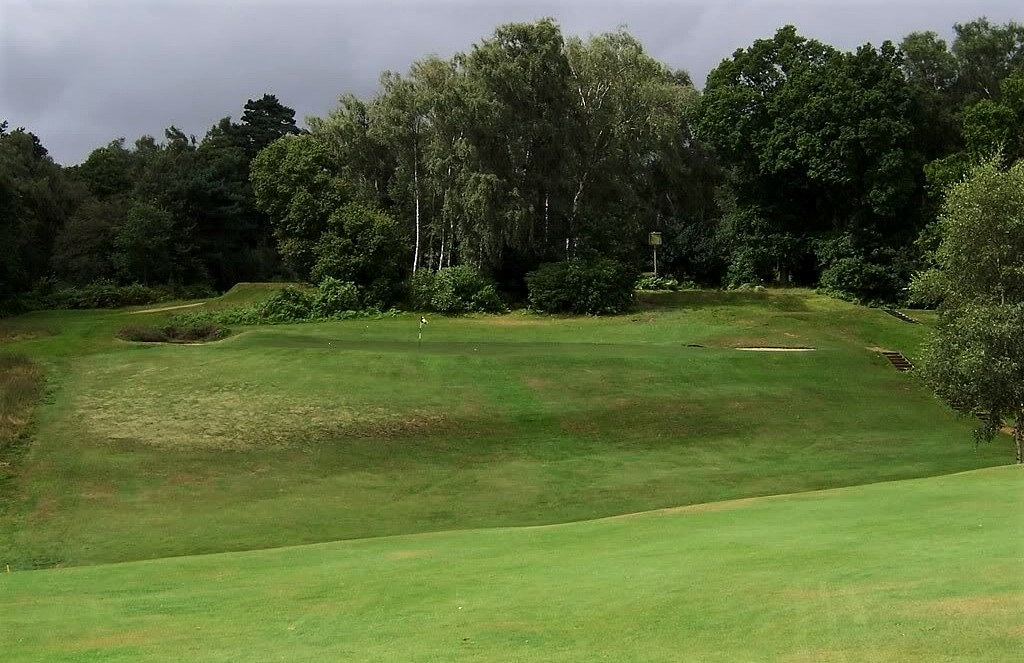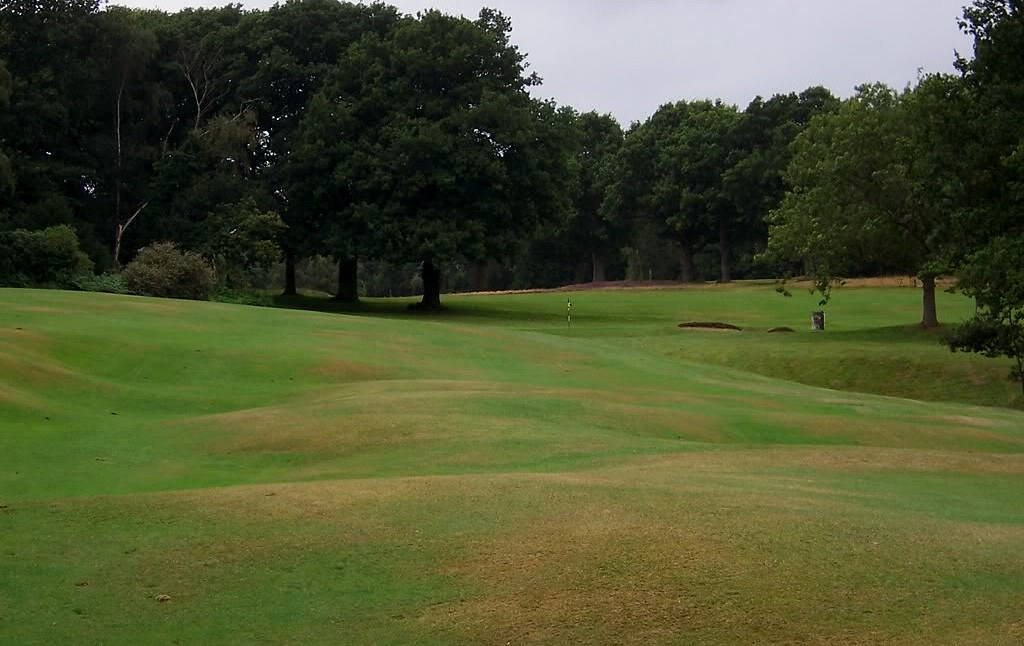Formerly a deer park, Stoneham was built in 1908 to a Willie Park Jr design. HS Colt did significant work to the course circa mid 1920s. The routing is unusual in that the front nine runs counter clockwise around the perimeter of the property and the back nine essentially flows clockwise inside the front nine loop (shades of Muirfield!). Combined with the hilly property, the effect is disorienting, but exhileratingly so. Most of the holes play in a valley with a few gullies knifing the through property. It is the ample use of these gullies which give Stoneham much of its character.
During the past four years or so the club has embarked on Project 2020. The club engaged Ken Moodie and John Nicholson to recreate the former glory of Stoneham. As is the case with many clubs embarking on similar programs, the focus was on tree clearance, bunker renovation and turf improvement in conjunction with heather rejuvenation. With the tree clearance the course feels more vibrant. There are enthralling views over the course and some beautiful specimen trees now fully on display. Don't misundestand, Stoneham remains an essentially tree-lined course, but there is a refinement which is easy on the eye.
Overall, I am very impressed with the course, especially the par 4s and 5s (many of which will play like long 4s for those who aren't length challenged). Considering there are five par threes, the set doesn't stand out, with one exception, the 225 yard blind 7th.
The more open nature of the course is immediately apparent on the three-shot opener. Before and after. I am not sure why the forward bunker was removed.


The second shot is blind and runs downhill; consequently many people can reach the green in two. The green runs away from play, but there is a shelf near the front where the hole is located in the photo.

#2 is a decent par 3. The course really gets going on the third. To carry the dip requires a solid strike of maybe 250 yards, anything short leaves a blind approach. The longer carry on the left will leave a better line of approach. This hole is a great example of using the terrain well. Before and after.


The 4th is the first of many blind tee shots. In this instance, a burn lies about 250 - 270 out, very reachable for some. In the first photo it is easy to see the severely sloped fairway.


A tight hole, the short two-shotter 5th legs right between bunkers.

My drive caught the left bunker and left me in a very odd situation. Either due to the grade of the face, the sand not clinging to the liner or a combination of both, I couldn't get a stance. I simply slid down the face of what was essentially the bunker liner. In the end I just had to hit the ball before sliding too much...never experienced that before!

The sixth is another short par 5, but getting home in two is tough because the immediate approach to the green is on a plateau and protected at each corner by a bunker. Immediately left of this bunker is a great hollow which looks like it works for drainage. I am somewhat surprised the hole isn't oriented to use this feature better. Perhaps the area gets too wet in winter.

If the green can't be reached, one must decide on laying up for a fairly level approach or being stuck well below the green with a possible blind approach. There are a handful of these type holes at Stoneham...rather reminds me of many a Ross course.

The 7th is most unusual; a 225 yard blind par 3. The terrain swings in from the dangerous boundary on the right side of the hole and works around a front left bunker. I must say that I admire the hole without totally liking it. In other words, it makes me feel very uncomfortable on the tee. Every course needs holes like this which niggle the player.
The 8th is another one shotter. Its not a bad hole, but somehow I think better use of the land could have been achieved. Its a bit of a letdown considering how the previous holes used the land expertly. Before and after.


The 9th isn't one of the standout holes, yet there is a certain attraction in trying to reach the top of the ridge.

This isn't one of the best stretches of the course because two of the short holes lack the flair of many two-shotters. In the 10th we get another short hole, the third in four holes. I do, however, like the deceptively large green.

We now commence a purple patch of holes from 11-15. Below is the approach to the shelf green 11th. Before and after.


A lovely par 5, the twelfth plays longer than its suggested yardage. While reachable (except for 18!); all of the par 5s at Stoneham share this characteristic. A good drive will finish blindly beyond the right bunker.



The course (in praise of yellow tees!) clocks in at just under 6000 yards, though it does feel longer. Part of the reason for this is the plethora of par fives. Balanced against these par 5s are five short holes and two par 4s under 300 yards. In modern design it has often been the case that the yadage range from 225ish to 300ish is ignored. This is most regretable because holes such as the thirteenth don't get built. Being 250 yards this is a reachable hole, but blind and with trees guarding the left of the green. The smart play is a 200 yard layup leaving a shot straight up the narrow green, but the temptation is just too much for most golfers who can reach the putting surface. It easy to see how being on the safe right side of the fairway leaves the golfer with nothing but headaches.

#14 continues the fun with a slinging legger to the right. This par 5 is reachable, but dangerous. Below is a view of the terrain and how a pushed 2nd leads to a blind third. The fairway feeds beautifully into the green with a hard left to right roll.


Hang onto your hats because 15 is another rollercoaster.


#16 is a short, uphill par 3 with fronting bunkers similar to #8. The green pinches on the left.

More water for the very good 17th. The stream for this low lying green was created about 25 years ago. It gives the hole a meadow-like feel which is welcome before the trials of the home hole.

Harshly uphill, the 18th comes at the wrong time in the round!

I am taken aback at the quality of Stoneham and I cannot praise it enough. While not strictly a heathland property, the club is keen to inject any possible heathand features into the course. Stoneham is every bit as good as many London courses, but like Beau Desert, it is in an unfashionable city (Southampton) and therefore receives few accolades. I am not convinced there are any All-England candidates holes, but the Stoneham package is delightful all the same. For anybody interested in seeing how a course uses its terrain supremely well, Stoneham should not be missed. 2019
Ciao